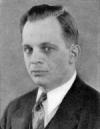
Harold Caminez
Harold Caminez, Engine Designer
by Daniel D. Whitney
Published 3 Apr 2019
 Harold Caminez |
Harold Caminez was born 1 March 1898 in Brooklyn, New York to Jacob and Bertha Caminez. Jacob had arrived in New York from Poland in 1888 at the age of 15. He married Bertha in New York in 1893 and they had six children, Harold being the third. Harold died 29 July 1943, in the crash of a commercial DC-3 airliner near Trammel, Kentucky. At Cornell University he played football in 1919 and graduated with a BSME in 1919, following which he received his MSME in 1920. [Cornell Alumni News, Volume 46, Number 4, 15 August 1943] He is credited with having designed an unusual engine, which utilized a giant cam in place of a crankshaft, in 1917. Following graduation from Cornell he worked on the Liberty V-12 aircraft engine as a draftsman and engineer at McCook Field, Ohio, the U.S. Army’s research and development facility. There he received Army support for the development and demonstration of his unique “cam” type engine, with work on the engine beginning in 1923. On 31 March 1924 he applied for a patent on his cam engine, which was awarded 27 July 1926 as U.S. Patent No. 1,594,045.
This engine used a double-lobe cam on the driveshaft with the pistons connected to the cam via large roller bearings on their skirts which were in constant contact with the cam. The pistons were kept in their relative positions by paired link rods to the adjacent piston through a rhombic parallelogram arrangement. The engine operated on the conventional 4-stroke Otto cycle with the result that the pistons were effectively running at twice the speed of the output cam, completing all four strokes for ever rotation of the cam. The 4-cylinder, air-cooled radial prototype engine first ran at McCook field 18 July 1924, and although there were problems and issues, the Army concluded in February 1925 that the “… operation and performance were satisfactory and that the engine should be developed further.”
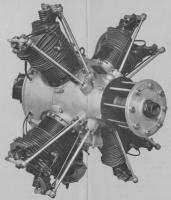 |
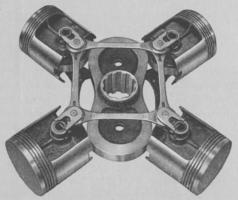 |
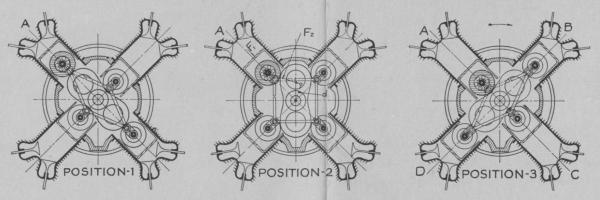 |
| Fairchild-Caminez Model 447-C Engine |
Cam Mechanism | Operating Principle |
In 1925 Caminez left the Army’s employment to develop his “cam” engine, joining with the Fairchild Aerial Camera Corporation of Farmingdale, Long Island, NY, and creating the Fairchild-Caminez Engine Corporation, for which he was both President and Chief Engineer. By May 1925 the engine was ready for testing, and in June a 50-hour test was attempted. Considerable testing and development ensued, and on 1 June 1928 the Department of Commerce Aeronautics Branch awarded the Model 447-C engine Type Certificate No. 1.
On 12 April 1926, R. H. Depew made the first test flight with an engine having no crankshaft. The engine was later exhibited at the Franklin Institute in Philadelphia, and an improved model was given to the Smithsonian in Washington, D. C. Nelson Kelly, accompanied by William Stockert, in 1928 flew a Caminez-powered plane 6,300 miles on the Ford Reliability Tour. The plane “Wings of Sayville’’, with a Caminez engine (135 horsepower at 1,000 rpm) was exhibited at the Pennsylvania Hotel in Manhattan. In April 1928, Ruth Rowlands Nichols flew a similarly powered plane at the Hartford Industrial Show.
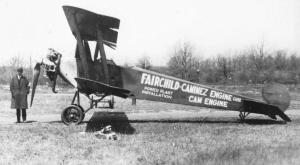 |
 |
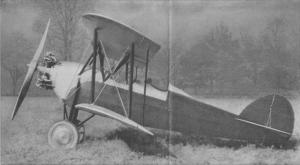 |
| Initial flight testing was done in an Avro 504. | L to R: Caminez, Depew and Fairchild, after First Avro 504 Flight |
First Production Cam Engine in Waco Ten |
The cam engine had a serious torsional vibration problem that was never satisfactorily resolved, a fact that made it unsuitable for use in an aircraft, although it was flown in a number of them. Towards the end of 1928, it was realized that the engine’s limitations could not be overcome. Although simple and reliable, the cam engine was not as smooth-running as the public wanted, and in addition to the vibration problems, the piston’s short stroke caused high pressure on the cylinder walls and kept the horsepower and the RPM from being increased.
In October 1928 an advisory group to the Fairchild-Caminez Engine Corporation determined that in addition to the $800,000 already spent, at least another $2M was needed to complete engine development. The Board decided to abandon the engine, following which Caminez resigned from the Fairchild-Caminez Engine Corporation. [The Fairchild-Caminez, by Lesly N. Forden, in Sport Aviation, 1973, Vol. 22.]
Two years and the funds expended on the project had brought together the facilities and personnel that were soon to form the Ranger Engine Division of the Fairchild Engine & Airplane Corporation. In May 1929 the Fairchild Engine Corp. came into being and development started on an inverted in-line, air-cooled engine, an idea of Walter F. Davis, formerly chief designer at Wright Aeronautical. He became chief engineer at Fairchild, assisted by John Bennett Tallman and Ronald M. Hazen, who later became chief engineer at the Allison Division of General Motors.
Details of what happened next are not clear, but by May 1929 the company became known as the Fairchild Engine Corporation, and Caminez had separated from the operation. As a first product Fairchild began development of the 6-370A engine, and inverted air-cooled six cylinder inline engine for training and private aircraft. Patent applications relative to this engine were submitted under the name of Walter F. Davis, beginning in December 1931. See U.S. Patent Nos. 2,037,708 and 2,043,529. An interesting feature of the cylinder designed for this series of engine, ultimately becoming the Ranger L-440, was the valve gear, which was operated from a single central camshaft with roller rockers to valves inclined at 22.5° from the cylinder centerline. This same arrangement was used in the Allison V-1710, for which Caminez received patent No. 2,024,334.
Allison’s Chief Engineer, Norm Gilman, and his team at Allison Engineering Company began the design of the V-1710 as a liquid-cooled V-12 in May 1929. Harold Caminez was soon brought in, specifically to do the detailed design and analyses of the new engine. This is shown in his report of September 1930. [Stress Analysis of Allison VG-1710 Engine, Rated 750 HP at 2400 RPM, Report Serial No. 26, by H. Caminez, 24 September 1930.] In an ASME paper in 1935 titled “Large Engine Development” he succinctly describes the rational for sizing and laying out the features of the V-1710. Clearly, he was involved in the V-1710 from the beginning, holding the position of V-1710 Project Engineer. In March 1933, Caminez and Gilman jointly applied for a patent (No. 2,098,718) on a supercharger drive and manifold system for the V-1710. However, by 1936 the V-1710 was in trouble, unable to pass the 150-hour Type Test. At this point Norm Gilman brought in Ron Hazen, then working at the General Motors Research Corporation, and in anticipation of his own retirement, named Hazen Chief Engineer. Harold Caminez left Allison at this time.
Caminez then went to work for the Aircraft Screw Products Co., Inc., Long Island City, New York. There he was responsible for a number of fastener related developments, many resulting in U.S. Patents. A key invention of his was the “Heli-coil” thread insert and the “Aero-Thread” insert of July 1936 (Patent No. 2,150,875), interestingly utilized exclusively on the mounting pads of the production V-1710.
Harold had not lost hope for engine development. In 1937 he proposed an improved and enlarged V-1710 type engine, his liquid-cooled V-2120. [Caminez V-2120 Aircraft Engine, Inter-Office Memorandum, Air Corps Material Division, F.O. Carroll, Major, Chief Experimental Engineering Section, July 2, 1940 and attachment of October 7, 1937.] This he proposed to the U.S. Army Air Corps in June 1940, however they determined to not proceed with the project. Notable differences between the two engines were the use of two valves in a hemispherical combustion chamber, compared to the pent-roof, four valve arrangement of the V-1710. He also used two camshafts running the length of each block, whereas the V-1710 used only one. A major feature was that the camshafts could be “shifted” during operation so that the valve timing was changed from “normal,” for use in cruise and below, and a wide timing overlap for operation at high power. Interestingly, this is a feature incorporated in the later Lycoming XR-7755, which was designed under his leadership beginning in 1942. For the V-2120 he also changed the induction system so that separate gas pipes led to manifolds on the outside of each bank, with the exhaust exiting in the Vee. Even so, the Vee was clear enough so that a cannon could be fitted, with the barrel protruding through the hollow propeller drive shaft, which was driven by a spur gear type reduction gear set. The pistons were 7.25:1 compression ratio, compared to 6.65:1, for even better fuel economy, which was possible because of the ability to retard timing when the valves were shifted to the wide overlap position. Two combination magneto/distributors were used, firing two sparkplugs located on the crown of the combustion chamber, rather than the dual magneto with two distributors used on the V-1710.
It is not clear when Caminez left Aircraft Screw Products, and he may have remained a consultant to them. At the time of his death he was Chief Engineer of Aviation Corporation's Lycoming Engine Division, Williamsport, Pennsylvania, responsible for the development of its 5,000 hp liquid-cooled XR-7755, and engine with 36 cylinders arranged as 9 cylinder blocks of four cylinders each.
Caminez was among the 20 people, out of 22, who perished near Trammel, Kentucky, in the crash of American Airlines flight 63, DC-3 Flagship Ohio, on the night of 28 July 1943. Also on the flight were two other individuals from the Lycoming Division of Aviation Corporation, S.K. Hoffman, Chief Engineer, who survived, and W.K. Cooper, Vice President of Sales for Aviation Corporation, who perished. The cause of the crash was loss of control due to severe turbulence and violent downdrafts.
In his short life Harold Caminez made numerous significant contributions to the development of the aviation engine. While his cam engine was not a success, it is still one often mentioned in the development of the aircraft piston engine, and he certainly learned a lot from it. His analytical work on the VG-1710 is exemplary, and set the standard and necessity for such analysis. Many factors contributed to the problems the early V-1710 encountered in completing its Type Test. Certainly the small engineering staff available at Allison coupled with the Army desiring several versions of the engine, as well as requiring fuel injection and concurrent development of a doubled V-1710, the X-3420. Ron Hazen is credited with saving the V-1710 program and turning it into a creditable engine able to fight WWII. Caminez went on to be quite successful at Aircraft Screw Products, where he was very inventive. We do not know how much he actually contributed to the Lycoming XR-7755, but it would appear that the cam shifting scheme he designed for the V-2120 was one feature he introduced. That he lost his life while traveling for Lycoming is a reflection of his dedication to aviation and the advance of the aircraft engine.
| Patent No. | Filing Date | Title |
|---|---|---|
| 1,588,166 | 12/09/1920 | Hydraulic Clutch |
| 1,496,704 | 06/29/1921 | Pump for Hydraulic Transmission |
| 1,793,904 | 03/21/1923 | Cam Type IC Engine |
| 1,608,770 | 03/29/1923 | Valves for IC Engines |
| 1,610,548 | 05/17/1923 | Engine Pressure Recorder |
| 1,594,045 | 03/31/1924 | Cam Engine |
| 1,595,070 | 11/16/1925 | Oil System for Cam Engines |
| 1,711,260 | 11/16/1925 | Cam Construction for Cam Engines |
| 1,578,877 | 12/14/1925 | Piston for Cam Engines |
| 1,681,219 | 04/02/1927 | Engine Mounting |
| 1,687,265 | 04/02/1927 | Piston in Cam Engine |
| 1,714,847 | 04/02/1927 | Cam Type IC Engine |
| 1,771,246 | 04/02/1927 | IC Engine Rockers |
| 1,723,012 | 11/25/1927 | Aircraft Engine Mount |
| 1,801,953 | 03/01/1928 | Engine Case Breather Valve, Fairchild |
| 1,734,155 | 10/01/1928 | Fuel Pump |
| 1,923,404 | 04/15/1931 | Glycol Airplane Radiator, Harrison/GMC, with James A. White |
| 1,943,479 | 02/23/1933 | Oil Pressure Relief Valve, General Motors Corp |
| 2,024,334 | 03/17/1933 | Valve Mechanism for V-1710 (Roller Rockers) |
| 2,098,718 | 03/17/1933 | Supercharger Mechanism for V-1710, with Norm K. Gilman |
| 2,001,866 | 05/31/1933 | Accessory Housing for V-1710 |
| 2,150,875 | 07/18/1936 | Method of Connecting Light Metal Parts, Aero-Thread (early) |
| 2,150,876 | 02/12/1938 | Screw Fastening for High Strength, Aero-Thread, AC Screw |
| 2,152,681 | 12/20/1938 | Screw Connection, Aero-Thread |
| 2,210,061 | 01/24/1939 | Aero-Thread Inserting Tool |
| 2,244,824 | 01/24/1939 | Aero-Thread Extracting Tool |
| 2,311,329 | 11/24/1939 | Shrunk Connection using Aero-Thread |
| 2,257,089 | 12/01/1939 | Aero-Thread Stud Driver |
| 2,295,931 | 04/26/1941 | Relief Valve |
| 2,278,688 | 07/09/1941 | Accumulator |
| 2,360,047 | 01/31/1942 | Means for Coiling Aero-Thread Inserts |
| 2,438,145 | 11/27/1942 | Method of Making Engine Manifolds, Avco Manufacturing |
| 2,371,674 | 12/24/1942 | Method of Forming Wire Coils, Aero-Thread |
| 2,567,482 | 02/18/1944 | Lay Shaft Construction, Avco Manufacturing, with Samuel K. Hoffman, filed posthumously |